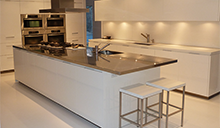
MY PROJECTS
CLICK IMAGE TO GO TO CATEGORY
Modern/Contemporary Kitchens
Modern/Contemporary Style
Modern style describes an era-specific design style that came into being during the 20th Century; mostly between the 1920’s and 1960’s. Originally it was based on the age of mechanization, but in today’s terms, it describes a very clean, uncluttered, and minimalistic aesthetic. Both symmetry and asymmetry work well with this style as long as the intent is pure design.
From my perspective, Contemporary is a softer, less rigid modern and I have combined these styles into one category. With this style, we always have flat panel doors, often thicker, built-up or very slim counters, the backsplash is usually a continuous and sleek material, and the
color palette is simple and minimal. With this style every accent object and should be carefully selected since it will be highlighted against the elegant, uncomplicated background.
Transitional Style
Transitional style is a blend of modern, clean lines with more warmth and more decoration. My interpretation describes an eclectic mix of modern and current–contemporary styles which reflect an updated approach to design.
The styles of cabinet doors tend not to be a flat panel, but may instead have a recessed panel. The lighting might be more decorative, and the tiles may or may not have more detail, regardless, there is a clean and sophisticated look to the space. This style is comfortable and elegant for the majority of people; they can readily appreciate what they are seeing and feeling.
Traditional/Country Style
Traditional design has its roots in the 18th century English and French countryside. There tends to be more decorative details in the treatment of wood carving, turnings, and crown moldings. We may use foot details at the bases of cabinets, and corbels or brackets at the wall cabinets. There can be an eclectic mix of many different textures and styles and this is totally acceptable and fun; there are few “rules” with this style.





